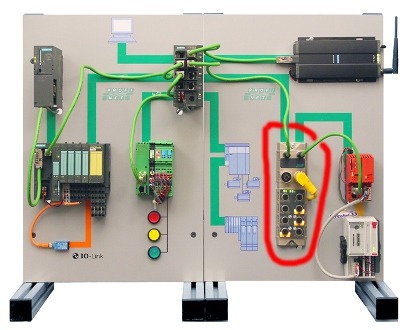I was amused by these dueling viewpoints in recent Control Engineering articles:
- Ethernet for sensor networks? Why it makes sense today
- Consider a sensor network to ease connections
The first one argues for network-connected, machine-mounted IO that can be close to the sensors and actuators. That’s a good argument and I fully agree with it. There are many machine-mountable IO blocks with PROFINET (and PROFIBUS) connectivity. It makes sense to group sensors and actuators inputs and outputs close to where they are, allowing a single cable run back to the controller. And that cable run can make stops at other IO blocks near other clusters of sensors and actuators. We actually demonstrate this in our PROFINET one-day training classes; look at the device circled in red (on one of our training racks):
The second article basically says Industrial Ethernet is bad – AS-interface is good. This is just wrong – each has its place. There are projects where clustering the IO as the first article advocates makes sense; there are other projects where the IO is spread out and AS-i makes sense. I see AS-i as an occasional complement to PROFINET; it is definitely not a replacement for PROFINET. In fact, AS-i is so much a complement to PROFINET that PROFIsafe can integrate AS-i safety.
There is another mistake in this second article which must be corrected. In fact there are two errors in the section “Wasted resources.” It says that PROFINET requires special hardware. WRONG! PROFINET can use standard Ethernet controllers with a PROFINET stack. PROFINET can also utilize silicon to meet regular real-time IO needs (which is what AS-i does… and PROFIBUS, and DeviceNet, and FF, and most other fieldbuses.) PROFINET can also utilize silicon to achieve greater levels of speed and determinism.
The second error in the article says that coexistence of Industrial Ethernets will no longer be possible. Also wrong! One of the great things about Ethernet is its ability to support multiple applications at the same time. Your email arrives even while you are surfing the web. Modbus TCP, EtherNet/IP, and PROFINET can coexist on your infrastructure (cables and switches) with each other and with web servers in Ethernet switches and with other standard Ethernet traffic.
Now back from error-correction mode: When it comes to resolving these dueling viewpoints, my advice as always is: “Do the engineering.” Evaluate the alternatives. Remember that cost is a legitimate design parameter. Study, if needed. Then choose the architecture that is right for your project. I’m convinced you will choose a PROFINET backbone complemented if needed by such other buses as the requirements may demand. I even wrote an article about that for Control Engineering and Plant Engineering: Fieldbus in the field.
–Carl Henning

